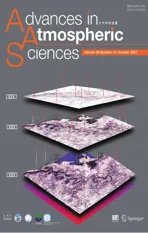Dominant Modes of Interannual Variability in Atmospheric Water Vapor Content over East Asia during Winter and Their Associated Mechanisms
2021-09-17WenyueHEBoSUNandHuijunWANG
Wenyue HE ,Bo SUN ,and Huijun WANG
1Nansen-Zhu International Research Centre,Institute of Atmospheric Physics,Chinese Academy of Sciences,Beijing 100029,China
2University of Chinese Academy of Sciences,Beijing 100049,China
3Collaborative Innovation Center on Forecast and Evaluation of Meteorological Disasters/Key Laboratory of Meteorological Disaster,Ministry of Education,Nanjing University of Information Science and Technology,Nanjing 210044,China
4Southern Marine Science and Engineering Guangdong Laboratory (Zhuhai),Zhuhai 519080,China
ABSTRACT Atmospheric water vapor content (WVC) is a critical factor for East Asian winter precipitation.This study investigates the dominant modes of interannual variability in WVC over East Asia during winter and their underlying mechanisms.Based on the empirical orthogonal function (EOF) method,the leading mode (EOF1,R2=28.9%) of the interannual variability in the East Asian winter WVC exhibits a meridional dipole pattern characterized by opposite WVC anomalies over northeastern China and eastern China;the second mode (EOF2,R2=24.3%) of the interannual variability in the East Asian winter WVC exhibits a monopole pattern characterized by consistent WVC anomalies over eastern China.EOF1 is mainly modulated by two anomalous zonal water vapor transport (WVT) branches over northeastern China and eastern China,which are associated with an anomalous atmospheric wave train over Eurasia affected by sea ice cover in the Kara Sea-Barents Sea (SIC-KSBS) area in the preceding October-November (ON).EOF2 is mainly modulated by an anomalous westerly WVT branch over eastern China,which is associated with a circumglobal atmospheric zonal wave train in the Northern Hemisphere.This circumglobal zonal wave train is modulated by concurrent central and eastern tropical Pacific sea surface temperature anomalies.The SIC-KSBS anomalies in ON and the concurrent SST anomalies over tropical Pacific may partially account for the interannual variability of EOF1 and EOF2 winter WVC,and thus may provide a theoretical basis for improving the prediction of winter climate over East Asia.
Key words:interannual variability leading modes water vapor content East Asia
1.Introduction
Atmospheric water vapor content (WVC) plays an important role in the global water cycle and climate system(Kaufman and Gao,1992;Trenberth et al.,2007;Yang et al.,2008;Bengtsson,2010;Boucher et al.,2013;Varamesh et al,2017).Atmospheric water circulation in winter has an extremely important effect:the amount of precipitation directly affects crop growth and agricultural yields in the coming year (Gao and Yang,2009).Furthermore,when precipitation is lower in winter,it will cause winter drought and seriously affect people's lives,whereas when precipitation is higher,precipitation often takes the form of snow or freezing rain,which can greatly affect transportation and potentially threaten public safety (Tao and Wei,2008).In East Asia,the WVC is a critical factor for precipitation during winter,which is mainly affected by large-scale water vapor transport (WVT;Zhai and Eskridge,1997;Sun and Wang,2013;Peng and Wu,2018;Sun et al.,2019).For instance,Sun and Wang (2013) indicated that the preconditioning and simultaneous supply of water vapor are essential for the breakout and persistence of widespread snowfall events in northeastern China during winter.Peng and Wu (2018)found that the winter-spring drought phenomenon in the middle and lower reaches of the Yangtze River is closely related to the anomalous anticyclonic WVT circulation in the northern part of the plateau.Sun et al.(2019) proposed that the anomalous water vapor convergence induced by WVT anomalies was a key factor in triggering the two intense snowfall events in central-eastern China during January 2018.
On the global scale,the WVC in the atmosphere has been increasing over the past few decades (Trenberth et al.,2005;Oksanen et al.,2018).However,the WVC over most areas of China exhibited a decreasing trend from 1958 to 2001 (Yu et al.,2001;Dai and Yang,2009).In addition,the variations in WVC in different regions of China and during different seasons are also distinct (Lu and Gao,1984;Cao et al.,2005;Yao et al.,2012;Hu et al.,2015).This discussion illustrates the complexity of the atmospheric water circulation system in East Asia.Despite the above studies,the study of leading modes of interannual variability in the winter WVC over East Asia is lacking.Understanding the interannual variability in winter WVC over East Asia is thus an important research topic.
Atmosphere WVC is usually modulated by atmospheric moisture advection and local evaporation.The contribution of the external WVT to WVC in the East Asian continental region is much greater than that of local evaporation(Trenberth,1999;Zhou and Wang,2006;Li et al.,2009).The winter WVT is largely regulated by the East Asian winter monsoon (EAWM).Previous studies of the EAWM mainly considered wind and temperature to illustrate the variability of the EAWM (e.g.,Guo,1994;Ji et al.,1997;Jhun and Lee,2004;Wu et al.,2006,b;Wang et al.,2010;Chen et al.,2019).The winter WVT,which is closely related to the EAWM,plays an important role in supplying water vapor.In this study,we focus on the variability of winter WVC over East Asia,which may provide a new perspective for the variability of the EAWM on climate.The factors affecting the EAWM include external forcing factors and internal dynamic processes (Chen et al.,2000;Huang et al.,2003;Zhou and Wang,2006;Li et al.,2018;Fan et al.,2020).The EAWM is closely associated with the tropical Pacific sea surface temperature (SST) and the related air-sea interactions (Wang et al.,2000;Wang and He,2012;He and Wang,2013).For instance,Wang et al.(2000) indicates that anomalous warming (cooling) of SST in the central and eastern tropical Pacific (CETP) can cause anomalous anticyclones (cyclones) over the western North Pacific(WNP) and lead to anomalous southerly (northerly) winds over East Asia during winter.This theory constructs a remote correlation model between the SST in the tropical Pacific Ocean and the East Asian region and is considered to be an important mechanism by which the El Niño-Southern Oscillation (ENSO) influences the interannual variability in the East Asian winter climate (Zhang and Sumi,2002;Wu et al.,2003;Yang et al.,2008;He et al.,2017).Zhou et al.(2007) proposed that the link between the EAWM and ENSO has been erratic over the past few decades and is characterized by a significant (nonsignificant) correlation before(after) the 1970s.In addition,the EAWM circulation is also associated with the anomalous Arctic Oscillation (AO;Thompson and Wallace,1998),the Antarctic Oscillation(Thompson and Wallace,2000),and the North Pacific Oscillation (Wallace and Gutzler,1981).Chen et al.(2006)explained the interannual relationship between AO and the EAWM by the action of quasi-stationary planetary waves.He and Wang (2012) indicated that a weaker EAWM may have been caused by the significant strengthening of AO since the mid-1980s.However,most of these studies focus on the factors influencing the East Asian winter climate,whereas the underlying mechanisms of the dominant modes of WVC over East Asia lack investigation.
Thus,the current study attempts to explore and answer the following questions:(a) What are the leading modes of interannual variability in WVC over East Asia during winter? (b) What are the underlying mechanisms of these dominant modes and the driving factors? The rest of this paper is organized as follows.The data and methods used in this study are described in section 2.Section 3 investigates the features of climatology and the leading modes of interannual variability in WVC during winter over East Asia.In section 4,the mechanism of the leading modes of interannual variability in WVC are analyzed.Section 5 gives a brief discussion on the potential roles of the SIC-KSBS anomalies in ON and the concurrent SST anomalies over the tropical Pacific for improving the prediction of WVC over East Asia.A summary is given in section 6.
2.Data and methods
2.1.Data
The monthly reanalysis data used in this study are derived from the National Centers for Environmental Prediction (NCEP) reanalysis dataset (Kalnay et al.,1996),including specific humidity,near-surface (2 m) temperatures,zonal and meridional winds,geopotential heights,vertical velocities,sea level pressure,and net surface shortwave radiation (Rayner et al.,2003).Except for the surface heat flux data,which are on a 192 × 94 Gaussian grid,these data have a horizontal resolution of 2.5° × 2.5°.The NCEP reanalysis has been widely used in the studies of East Asian climate variability (e.g.,Li et al.,2013;Sun et al.,2018,2019;Shen et al.,2019;Fan et al.,2020;Jiang et al.,2020).This dataset uses a state-of-the-art analysis and prediction system to perform data assimilation over the entire period,which allows it to overcome the problems associated with changes in technology,models,and data assimilation in previous numerical weather prediction analyses (Zhang et al.,1997).The use of satellite data since 1979 has greatly improved the accuracy of the NCEP reanalysis data (Kistler et al.,2001).This study focus on the period of 1979–2017.
The monthly sea surface temperature (SST) data are derived from the NOAA-ERSST-v5 with a horizontal resolution of 2° × 2° (Huang et al.,2015).The monthly sea ice concentration (SIC) data are derived from the Hadley Center with a horizontal resolution of 1° × 1° (Rayner et al.,2003).The monthly precipitation used in this study is the GPCP Version 2.3 Combined Precipitation Data (2.5° × 2.5°),which is a high-quality dataset that combines data from satellites,gauge stations,and sounding observations (Adler et al.,2003).The monthly Niño-3 index and Arctic Oscillation(AO) index are derived from the NOAA Climate Prediction Center (https://www.esrl.noaa.gov/psd/data/climateindices/list/).The monthly hindcasts (1° × 1°) of SST used in this study are derived from CFSv2,which is derived from a fully coupled atmosphere-ocean-land-sea-ice model (Saha et al.,2014).There are 24 members,with distinct initial conditions in each forecast.An ensemble mean of all the members with equal weight is used in this paper.The CFSv2 data in winter (from December to February) covered the period 1982–2017 (this dataset dates from 1982),starting on 1 November.
2.2.Method
In this study,East Asia is defined as a rectangular region bounded by (90°–135°E,20°–60°N) (Fig.1a).An empirical orthogonal function (EOF) analysis is performed for the interannual variability in December–January–February (DJF) mean WVC over East Asia from 1979–2017.The method proposed by North et al.(1982) is used to examine whether the first several modes are independent of each other.Furthermore,to remove the low-frequency variability and retain the interannual variability,nine-year highpass filtering (Duchon,1979) is performed for all the data in this study before all the analyses unless otherwise specified.Note that the filtered data have missing values in the first and last four years of the time series.Linear regression analysis is performed to compute the climate anomalies associated with the leading modes of interannual variability in East Asian WVC,where the climate anomalies are regressed on the time series of the leading modes of WVC.The Pearson correlation coefficient is computed to estimate the correlation between the two time series.A student's ttest is used to examine the confidence level of the climate anomalies obtained from the above linear regression and the correlation coefficient.
The vertically integrated WVC is integrated from the surface towards the 300 hPa pressure level based on the method developed by Sun and Wang (2011).Considering that the specific humidity in the upper-level troposphere is much smaller than that in the lower-level troposphere (Sun and Wang,2013),the vertically integrated WVC between the surface and the 300 hPa pressure level may well represent the total WVC over East Asia.In addition,the specific humidity and zonal and meridional winds for eight levels are used for computing the vertically integrated WVT.In this study,positive (negative) surface heat flux anomalies denote upward (downward) surface heat flux anomalies.The wave activity flux is computed based on the 500 hPa geopotential height anomalies regressed on the standardized time series of EOF1 and EOF2 of East Asian WVC,using the method of Takaya and Nakamura (2001):

f
denotes the Coriolis parameter,and Nis the buoyancy frequency squared.In our study,the climatology of variables refers to the climatology for 1979–2017 unless otherwise specified.This study focuses on the winters of 1979–2017.The winter of 1979 refers to the winter beginning from December 1979 towards February 1980,and so forth.
3.Climatology and leading modes of interannual variability in WVC
3.1.Climatology of winter WVC and its relationship with precipitation
The spatial pattern of the climatology of the East Asian DJF WVC (Fig.1a) and the spatial pattern of the climatology of the East Asian DJF precipitation (Fig.1b) exhibits similar characteristics (r=0.61,p <0.01).Regarding the interannual variations,most regions present a consistent variation between WVC and precipitation over East Asia.For example,the time series of the regional mean WVC and precipitation are significantly correlated over south China(22°–34°N,100°–120°E;r=0.65,p <0.05),north China(34°–45°N,110°–120°E;r=0.78,p <0.05),northeast China (40°–54°N,120°–135°E;r=0.40,p <0.05),and northwest China (34°–42°N,90°–110°E;r=0.43,p <0.05).As shown in Fig.1c,the time series of East Asian regional mean WVC present a general consistency with the time series of East Asian regional mean precipitation,with a correlation coefficient of 0.62 which is significant at the 99% confidence level (Fig.1c).The above results indicate that the interannual variability of winter WVC and precipitation over East Asia are significantly correlated.However,it should be noted that the relationship between WVC and precipitation is different in different regions of East Asia during winter because of snowfall events.It is suggested that the interannual variability and mechanisms of snowfall vary between areas during winter (Wang et al.,2012;Zhou et al.,2018;Yang et al.,2020;Sun et al.,2021).For example,WVC plays a key role in the snowfall events in northern China,while strong cold advection plays a key role in the snowfall events in east-central China (Xie and Sun,2019).Thus,the relationship between WVC and precipitation may vary from areas over East Asia during winter.
Precipitation is influenced by many factors such as WVT and cold advection (Cui et al.,2009;Sampe and Xie,2010;Sun et al.,2019a,2021).Atmosphere WVC,as a representation of atmospheric humidity,could reflect the information of large-scale WVT and is directly related to atmospheric circulation (Zhou and Wang,2006;Li et al.,2009).The study investigating the dominant modes of interannual variability in WVC and the associated mechanisms may improve the understanding of interannual variability of WVC,which is an important predictor of precipitation.Therefore,the study of interannual variability in WVC and its dynamical mechanisms is of great importance.
3.2.Leading modes of interannual variability in WVC
Figure 2 shows the first two leading EOF modes of interannual variability in WVC over East Asia during winter for 1979–2017,which explain approximately 28.9% and 24.3%of the interannual variance in WVC,respectively,indicating that EOF1 and EOF2 can explain most of the interannual variability in WVC during winter over East Asia.Hence,the following discussions in this section focus on the first and second EOF modes.According to the North test(North et al.,1982),EOF1 and EOF2 are significantly separated from each other and the remainder of the EOF modes.The first EOF mode exhibits a meridional dipole pattern,which is characterized by positive anomalies over the regions north of 40°N,including northeastern China and Mongolia,and negative anomalies over the regions south of 40°N,mainly including eastern and southern China (Fig.2a).In contrast,the second EOF mode exhibits a monopole pattern,which is characterized by positive anomalies in most parts of East Asia with large anomalies situated over northern China (Fig.2c).
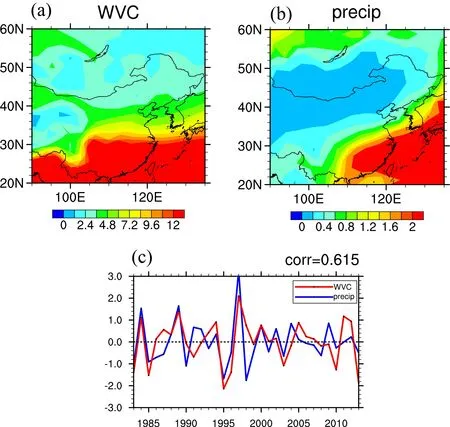
Fig.1.Climatology of the monthly means of (a) atmospheric WVC (shading units:kg m–1) and GPCP precipitation(shading units:mm) during winter over East Asia (20°–60°N,90°–135°E) for 1979–2017.(c) Standardized time series of areal mean WVC (red) and precipitation (blue) during winter over East Asia for 1979–2017,with the correlation coefficient labeled in the top-right corner of the panel.
Figures 2b and 2d show the standardized time series corresponding to the first and second EOF modes.The standardized time series of EOF1 (hereafter referred to as PC1) and EOF2 (hereafter referred to as PC2) both exhibit noticeable interannual variations.PC1 shows relatively small interannual variability before 2000 and relatively large variability after 2000,with a standard deviation of 0.89 during 1979–2000 and a standard deviation of 1.09 during 2001–2017.In contrast,PC2 shows a relatively large interannual variability before 2000 and a relatively small variability after 2000,with a standard deviation of 1.07 during 1979–2000 and a standard deviation of 0.84 during 2001–2017.The above results suggest an increased (decreased) influence of EOF1(EOF2) on the interannual variability in WVC over East Asia during winter.
4.Mechanisms or precursory climate signals associated with East Asian leading two modes during boreal winter
4.1.The first EOF mode
Figure 3 shows the anomalies of WVC and the atmospheric circulation patterns regressed on PC1 of WVC.Corresponding to a positive phase of EOF1,positive WVC anomalies occur over northeastern China and Mongolia,whereas negative anomalies occur over eastern and southern China(Fig.3a).These WVC anomalies are possibly caused by two factors:the large-scale WVT and evaporation.To examine the influences of evaporation and WVT,the surface latent heat net flux anomalies (figure not shown) and the divergence of vertically integrated water vapor flux anomalies(Fig.3b) regressed on PC1 of WVC are computed.The results indicate that the water vapor divergence anomalies are two orders of magnitude larger than the estimated evaporation anomalies based on the surface latent heat flux anomalies;therefore,we may pay more attention to the WVT anomalies.As shown in Fig.3b,the water vapor divergence anomalies are characterized by negative anomalies over northeastern China and positive anomalies over eastern and southern China,indicating anomalous water vapor convergence over northeastern China and anomalous water vapor divergence over eastern and southern China.
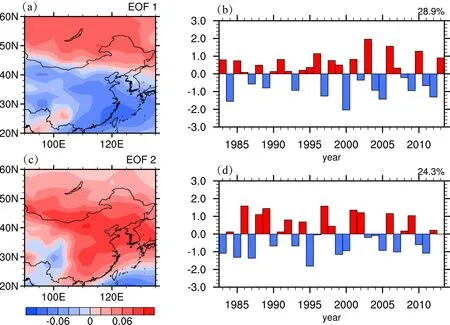
Fig.2.(a) EOF1 and (c) EOF2 of interannual variability in WVC during winter over East Asia for 1979–2017.(b)and (d) are the standardized time series corresponding to EOF1 and EOF2,respectively.The top-right corners in (b)and (d) are the corresponding percentage of explained variance to the total variance.

Fig.3.Anomalies of the (a) vertically integrated WVC (units:kg m–1),(b) vertically integrated water vapor flux divergence (units:kg m–2 s–1),(c) vertically integrated WVT (units:kg m–1 s–1),and (d) Z500 (color shading,units:gpm) regressed on the standardized time series of EOF1 of WVC during winter for 1979–2017 and the associated wave activity flux (units:m2 s−2,vector).Stippling in (a),(b),and (d) and color shading in (c) denotes where the anomalies are significant at the 95% confidence levels based on Student's t-test.
Besides,there is a positive correlation between atmospheric WVC and surface temperature [Fig.S1 in the Electronic Supplementary Material (ESM)].Surface air temperature may affect atmospheric WVC via the following two pathways.First,the surface air temperature could exert an influence on the atmospheric saturation water vapor pressure and saturation specific humidity (Held and Soden,2006).Whereas,the actual water vapor pressure and specific humidity depend on atmospheric WVC (Sun et al.,2011).Second,increased WVC may be concurrent with increased air temperature,because a relatively high air temperature may lead to intensified evaporation (Monteith,1981;Yang and Roderick,2019).The above results show that the influences of local evaporation on water vapor content are much smaller than that of WVT (Trenberth,1999;Zhou and Wang,2006;Li et al.,2009).Thus,our study mainly focuses on the effect of WVT on atmospheric WVC and pays less attention to the influences of surface air temperature on WVC.To further examine the large-scale WVT anomalies associated with the water vapor divergence anomalies,the vertically integrated WVT anomalies regressed on PC1 of the WVC are analyzed (Fig.3c).It is evident that an anomalous anticyclone occurs over Mongolia and that an anomalous cyclone occurs over the WNP,inducing northwesterly WVT anomalies over northeastern China and northeasterly WVT anomalies over eastern and southern China.These WVT anomalies may induce anomalous water vapor convergence over northeastern China and anomalous water vapor divergence over eastern and southern China (Fig.3b).The anomalous anticyclone over Mongolia and the anomalous cyclone over the WNP are caused by an anomalous high over Mongolia and an anomalous low over the WNP,respectively (Fig.3d).The question is,what are the drivers of these anomalous high and low?
4.1.1.Influence of the Arctic Oscillation and Arctic sea ice
During winter,the Arctic Oscillation (AO) exerts an important impact on climate anomalies over the mid-latitudes of Eurasia (Thompson and Wallace,1998;Wu and Wang,2002;Seo et al.,2020),where a positive phase of AO is generally featured by an anomalous high (low) over the mid-latitudes of the Eurasian continent (Arctic region),and vice versa.The 500 hPa geopotential height (Z500) anomalies regressed on PC1 (Fig.3d) exhibit a pattern resembling the positive phase of the winter AO,suggesting a possible relationship between the winter AO and EOF1 of the WVC.Hence,the interannual variations in the time series of the winter AO index and EOF1 of WVC are compared.As shown in Fig.4f,during the past four decades,the interannual variations in the time series of EOF1 of WVC and in the time series of the AO index are mostly coincident.Specifically,a correlation coefficient of 0.41 is observed between the two time series,which is significant at the 95%confidence level based on the Student’s t-test.These results suggest that the winter AO may exert an influence on EOF1 of the WVC by modulating the anomalous high over Mongolia.
Notably,although the AO is essentially an internal process of atmospheric circulation,the AO-like pattern in the Z500 anomalies associated with EOF1 of the WVC may partially be affected by external factors such as Arctic sea ice(Li and Wang,2012;Liu et al.,2012;Gao et al.,2015;Kug et al.,2015;Zhou et al.,2017).Based on Liu et al.(2012),reduced (increased) Arctic sea ice during the preceding autumn may induce atmospheric circulation anomalies resembling a negative (positive) phase of AO during winter.In addition,the wave activity flux of Z500 anomalies associated with EOF1 of the WVC exhibits an anomalous wave train over the mid-to-high latitudes of Eurasia,which partially originates from the Arctic and passes through Mongolia and southern China (Fig.3d).The above results imply a possible relationship between the Arctic climate anomalies and EOF1 of the WVC.
Figure 4a shows the mean SIC anomalies in ON regressed on the standardized time series of EOF1 of the WVC,which exhibit positive SIC anomalies over the Kara Sea-Barents Sea area (SIC-KSBS,75°–85°N,45°–110°E).These positive SIC anomalies may induce negative air temperature anomalies over the KSBS because of sea ice-albedo feedback (Curry et al.,1995;Sun,2017),leading to an increased climatic meridional gradient of air temperature(Fig.4c) and geopotential height (Fig.4e) between the midlatitudes of Eurasia and the KSBS area.According to the principle of thermal wind balance (Li et al.,1991),the above increased meridional gradient of air temperature and geopotential height may result in increased climatic westerlies(Fig.4d) and fewer meanders of the jet stream in the atmosphere over the mid-latitudes of Eurasia,which means that less cold air is permitted to flow from the Arctic region towards Siberia and Mongolia.As a result,an anomalous deep warm high may form over Mongolia (Fig.3d).
To further examine the influence of SIC-KSBS in ON on EOF1 of WVC,the anomalies of Z500,vertically integrated WVT,and atmospheric WVC regressed on the time series of mean SIC-KSBS in ON are analyzed.Corresponding to the PC1 regression (Figs.3a,c,d),the physical volume fields regressed on the time series of mean SICKSBS in ON are in opposite phases in southern and northern East Asia.The anomalous anticyclone and high occur over northeastern China and Mongolia,whereas the anomalous cyclone and low occur over the WNP (not shown),leading to positive WVC anomalies over northern East Asia and negative anomalies over southern East Asia (Fig.4b).Moreover,the time series of mean SIC-KSBS in ON and PC1 of WVC exhibit a significant correlation regarding the interannual variations,with a correlation coefficient of 0.40 which is significant at the 95% confidence level (Fig.4g).Of particular note is the inconsistency between the two time series during a few episodes,for instance,the late 1980s,the early 1990s,and the early 2000s,implying the presence of other influencing factors of EOF1 of WVC.
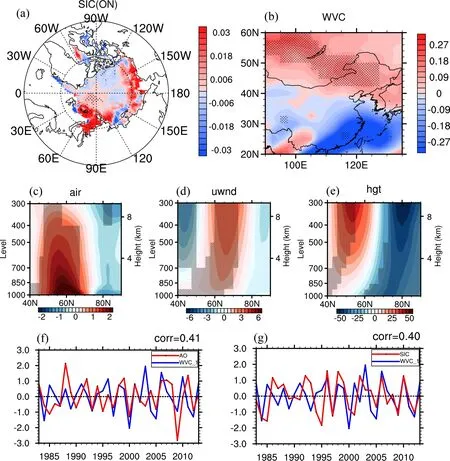
Fig.4.(a) Anomalies of the monthly mean SIC in ON regressed on the standardized time series of EOF1 of WVC during winter for 1979–2017.Anomalies of (b) the vertically integrated WVC regressed on the time series of mean SIC-KSBS in ON for 1979–2017.Anomalies of (c) the zonal mean air temperature (units:°C),(d) the zonal wind(units:m s–1),and (e) Z500 (units:gpm) averaged over (20°–90°E) during winter.Stippling in (a)–(e) denotes where the anomalies are significant at the 95% confidence level based on a Student’s t-test.Also shown are the standardized time series of (f) EOF1,of WVC (blue),and AO index (red) and (g) EOF1 of WVC (blue) and mean SIC-KSBS in ON (red),with the correlation coefficient labeled in the top-right corner of the panel.
4.1.2.Influence of tropical Pacific SSTs
Considering that EOF1 of the WVC is a meridional dipole mode with significant atmospheric circulation anomalies over southern China and the WNP (Fig.2b),the WVC over East Asia may be affected by low-latitude atmospheric dynamic processes.Figures 5a–c shows the SST,sea level pressure (SLP),and the 500 hPa vertical velocity regressed on PC1,which is characterized by few significant anomalies over tropical oceans.The results indicate that the dynamic process of tropical air-sea interaction has relatively little effect on EOF1 of the WVC,which may be related to the weakening effect of the tropical Pacific SST on the East Asia winter WVT through the "Pacific-East Asia" teleconnection mechanism in January after the late 1970s (Wang,2000;Sun et al.,2019).To illustrate the influences of tropical Pacific SST,the WVT anomalies regressed on the sign-reversed Niño-3 index [i.e.,Niño-3 index ×(–1)] are computed.As shown in Fig.5d,under La Niña conditions,an anomalous cyclone occurs over the WNP,which may induce anomalous WVT branches over eastern and southern China.Accordingly,these anomalous WVT branches cause water vapor divergence anomalies towards eastern and southern China,which may exert a negative effect on the WVC anomalies there.

Fig.5.Anomalies of (a) SSTs (units:°C),(b) sea level pressure (SLP,units:hPa),and (c) 500 hPa vertical velocity(units:10–3 Pa s–1) regressed on the standardized time series of EOF2 of WVC during winter for 1979–2017.(d)Anomalies of vertically integrated WVT (units:kg m–1 s–1) regressed on the sign-reversed Niño-3index during winter for 1979–2017.Stippling in (a)–(c) and shading in (d) denote where the anomalies are significant at the 95%confidence levels based on the Student’s t-test.Vectors in (b) denote the corresponding wave activity flux (units:m2 s−2).
Based on the above analysis,the winter AO and the SIC-KSBS in ON may play a dominant role in modulating EOF1 of the WVC by triggering a meridional wave train and modulating the gradient of air temperature between the mid-latitudes of Eurasia and the KSBS area.In addition,the influences of ENSO on the WVT anomalies over southern East Asia are relatively small but also considerable.
4.2.The second EOF mode
Figure 6a shows the anomalies of the vertically integrated WVC regressed on PC2 of WVC,which are similar to EOF2 of WVC and characterized by positive anomalies in most parts of East Asia.The WVC anomalies may be caused by increased evaporation (not shown) and anomalous water vapor convergence (Fig.6b) over East Asia.The anomalous water vapor convergence is mainly associated with anomalous zonal WVT branches across the western border of East Asia,which conveys moisture anomalies from western Siberia into northern East Asia (Fig.6c).Another factor for EOF2 of the WVC is an anomalous southerly WVT branch towards East Asia,which conveys moisture anomalies from the Bay of Bengal into East Asia.The anomalous WVT over East Asia is mainly controlled by an anomalous anticyclonic circulation centered over the WNP,which is related to an anomalous high there (Fig.6d).Hence,the anomalous high centered over the northern Pacific and northeastern China may have an important influence on EOF2 of the WVC.The question then arises:how is the anomalous high over the WNP induced?
Several studies have noticed the influences of tropical Pacific SSTs on the East Asian winter climate (e.g.,Weng et al.,2009;Ding et al.,2014;Kim et al.,2014;Sun et al.,2019).For example,previous results have indicated that the interannual variability in winter climate over East Asia may be influenced by the CETP and associated air-sea interactions.To examine the relationship between EOF2 of WVC and tropical Pacific SST,the SST anomalies are regressed on PC2 of WVC (Fig.7a).The results indicate that for a positive phase of EOF2,the tropical Pacific SST anomalies exhibit an El Niño-like pattern characterized by positive SST anomalies in the CETP.The warm SST anomalies in the CETP cause positive Z500 anomalies there and negative Z500 anomalies over the North Pacific (Fig.7b).This result is consistent with previous studies (Hoerling et al.,2001;Alexander et al.,2002;Toniazzo and Scaife,2006;Yu and Kim,2011;Kosaka and Xie,2013;Zhou et al.,2014) suggesting that the tropical Pacific SSTs can excite a northward propagating Rossby wave and produce a global long-distance teleconnection.Besides,the anomalous low over the central and eastern North Pacific may initially weaken the solar radiation reaching there (not shown),resulting in anomalous cooling in the central North Pacific.The cold SST anomalies in the central North Pacific provide a sinking driver for overlying convective activity in turn,resulting in the formation of an anomalous sinking branch there (Fig.7c),which may also trigger a Northern Hemisphere wave train.
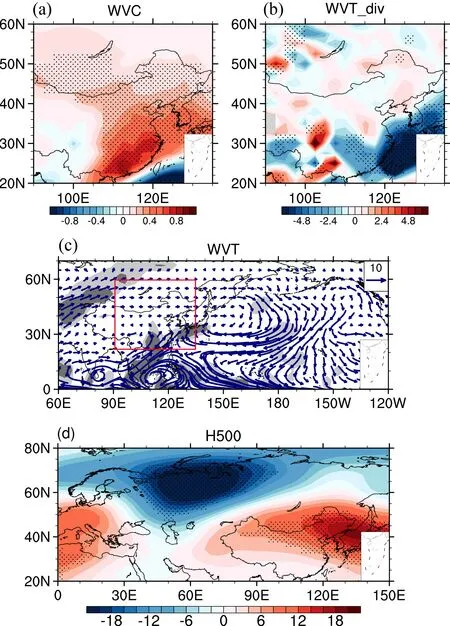
Fig.6.Anomalies of (a) vertically integrated WVC (units:kg m–1),(b) vertically integrated water vapor flux divergence (units:kg m–2 s–1),(c) vertically integrated WVT (kg m–1 s–1),and (d) Z500 (units:gpm) regressed on the standardized time series of EOF2 of WVC during winter for 1979–2017.Stippling in (a),(b),and (d) and shading in(c) denote where the anomalies are significant at the 95% confidence levels based on the Student's t-test.
Actually,the above anomalous Northern Hemisphere wave train is associated with a circumglobal teleconnection(CGT).Figure 8a shows the Z500 anomalies regressed on PC2 of the WVC and its wave activity flux.The results indicate that there is a circumglobal wave train over the mid-high latitudes of the Northern Hemisphere characterized by negative anomalies over the central and eastern North Pacific(25°–40°N,100°–140°W),the North Atlantic (40°–55°N,30°–60°W),and Siberia (55°–85°N,30°–90°E) and positive anomalies in northeastern America (50°–70°N,60°–100°W),western Europe (30°–50°N,15°W–15°E),and eastern Asia (30°–35°N,100°–170°E).Based on the method of Sun et al.(2019),a similar CGT index is defined,which is given by the averaged Z500 over the key regions occupied by an anomalous high minus the averaged Z500 over the key regions occupied by an anomalous low (Fig.8a).The wave activity flux suggests that the circumglobal wave train may partially originate from the central-tropical and central-subtropical Pacific and passes through North America and the Atlantic into Eurasia,eventually forming an anomalous high over East Asia.Therefore,the CGT may exert an influence on the anomalous high over WNP-northeastern China and hence EOF2 of the WVC.
When the time series of PC2 of WVC,the signreversed CGT index,and the Niño-3 index are compared,the three time series are mostly consistent in the interannual variations with each other with respective correlation coefficients of 0.75,0.49,and 0.55 (Fig.8b) which are significant at the 99% confidence level.This finding suggests that ENSO may have a significant impact on modulating EOF2 of WVC via CGT.Nevertheless,the inconsistency between PC2 of WVC and the time series of the Niño-3 index during the late 1980s,the early 1990s,and the early 2000s indicates a smaller influence of ENSO on EOF2 of WVC for these episodes,implying other influencing factors in addition to ENSO.
5.Physical Empirical Model for Prediction

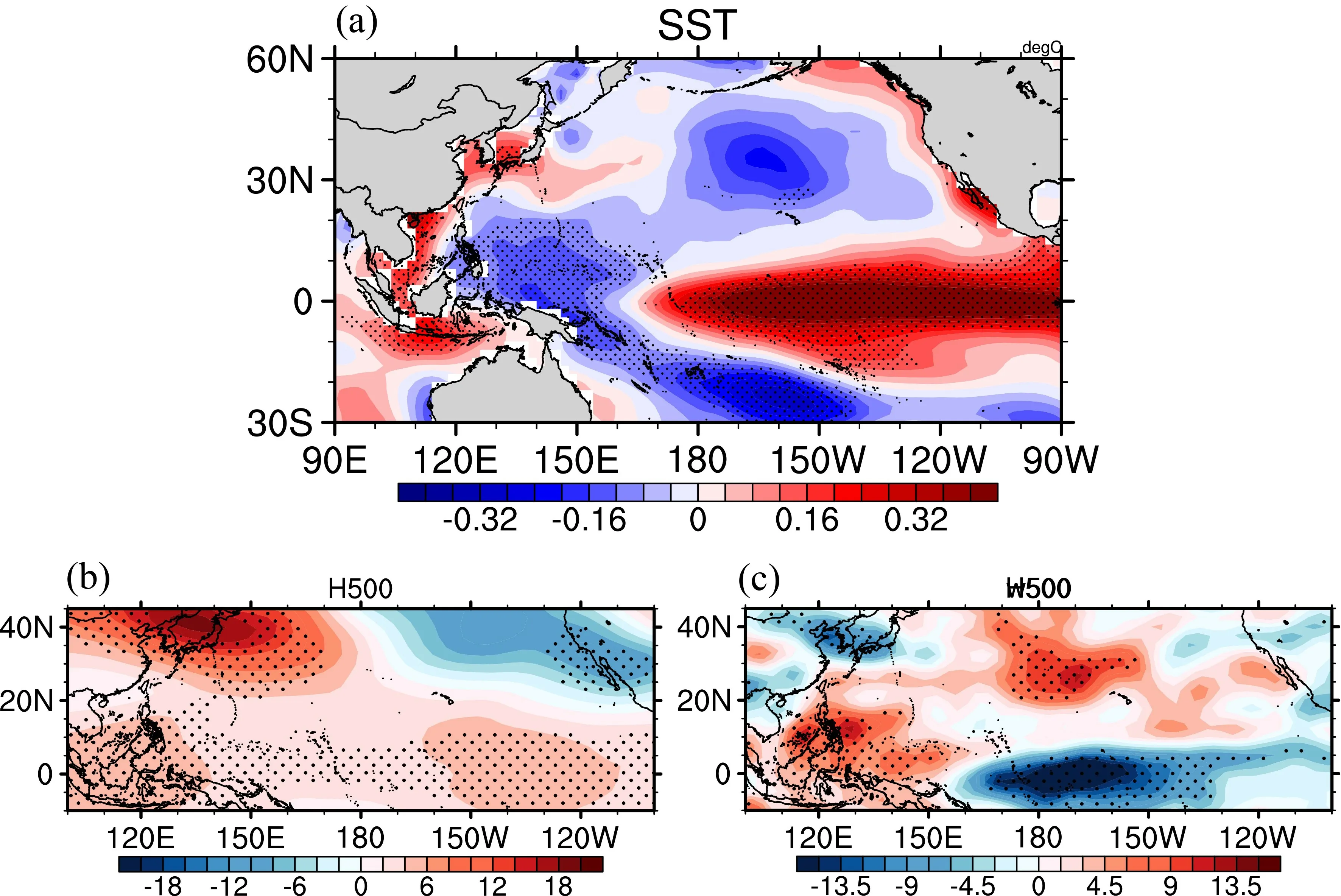
Fig.7.Anomalies of (a) SST (unit:°C),(b) Z500 (units:gpm),and (c) 500 hPa vertical velocity (units:10–3 Pa s–1)regressed on the standardized time series of EOF2 of WVC during winter for 1979–2017.Stippling in (a)–(c)denotes where the anomalies are significant at the 95% confidence levels based on the Student's t-test.
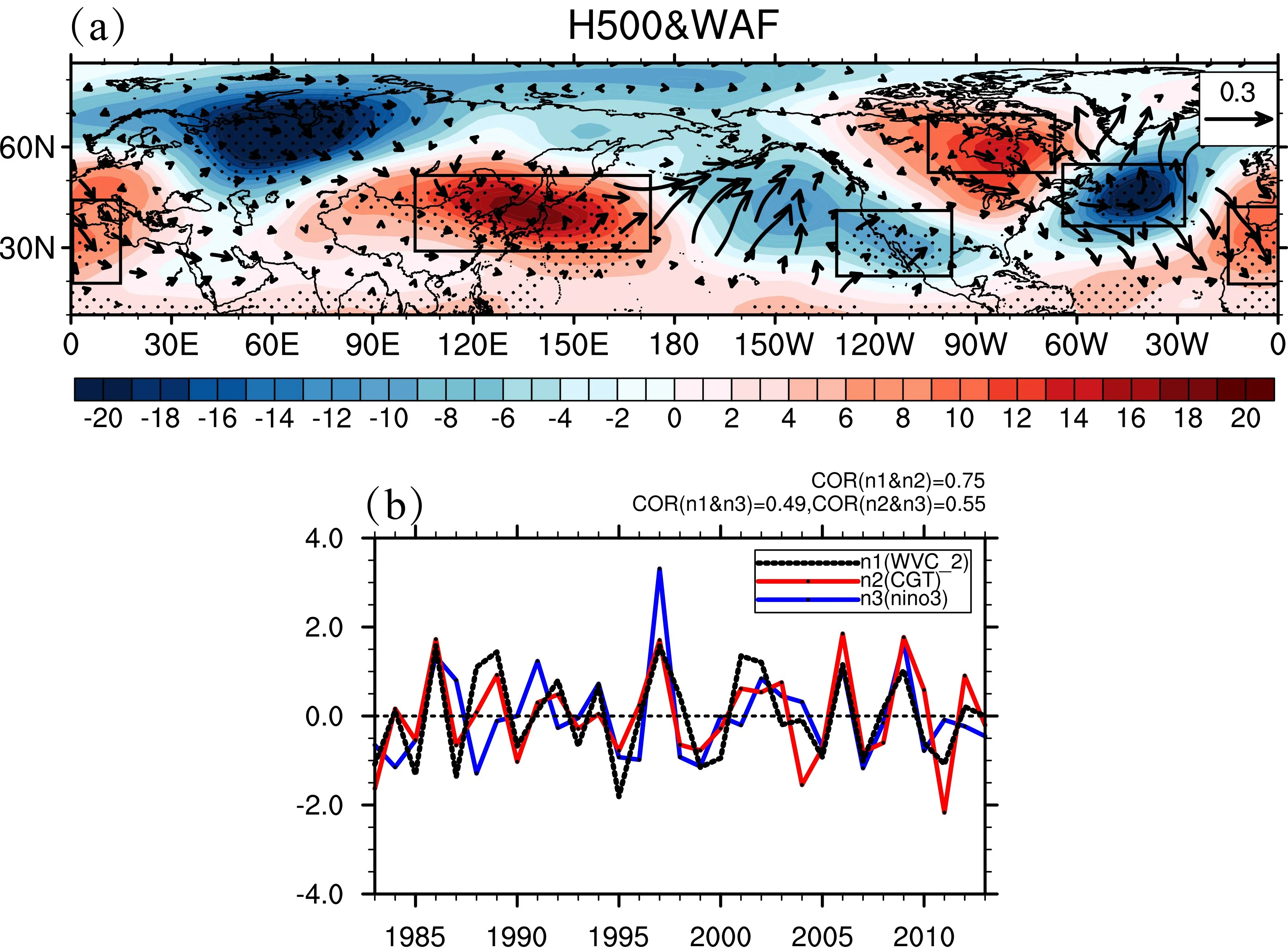
Fig.8.Anomalies of (a) Z500 (units:gpm,shaded) regressed on the standardized time series of EOF2 of WVC during winter for 1979–2017 and the associated wave activity flux (units:m2 s−2,vector).Stippling in (a) denotes where the anomalies are significant at the 95% confidence level based on the Student's t-test.(b) Standardized time series of EOF2 of WVC (black),CGT index (red),and the Niño 3 index (blue),with the correlation coefficient labeled in the top-right corner of the panel.
To assess the predictive skill of our prediction model,the one-year-out cross-validation (Michaelsen,1987) and independent hindcasts are performed.The one-year-out cross-validation approach predicts the predict and in the special year with a model built by the sample of leaving the year out.The independent hindcasts approach breaks the database into two periods,one used for training and another for verification.The prediction model for PC1 (hereinafter referred to as Scheme 1) is evaluated by cross-validation tests for the period 1983–2013 (31 years) and independent hindcast for 1999–2013 (14 years).The correlation coefficient between the predicted PC1 in the cross-validation test and the observed PC1 is 0.33,exceeding the 95% significance level (Fig.9a).The root-mean-square error (RMSE)between the predicted PC1 and the observed PC1 is 0.90.However,there are several years where the predicted PC1 shows a discrepancy with the observed PC1,such as the late 1980s,the early 1990s,and the early 2000s,which might be due to the limitation of the unicity of predictor.Moreover,Scheme 1 performs well in the independent hindcast.The correlation coefficient between the predicted PC1 in the independent hindcasts and the observed PC1 for 1999–2013 is 0.58,exceeding the 95% significance level (Fig.9b).The above results indicate that the SIC-KSBS anomalies in ON may partially account for the PC1 of winter WVC over East Asia.Whereas,the prediction model for PC2 (hereinafter referred to as Scheme 2) is evaluated by cross-validation tests for the period 1986–2013 (28 years) and independent hindcast for 1999–2013 (14 years).The correlation coefficient between the predicted PC2 of WVC in the cross-validation test and the observed PC2 of WVC is 0.58,exceeding the 95% significance level (Fig.9c).The RMSE between the predicted PC2 and the observed PC2 is 0.78.However,the discrepancy between the two time series during the late 1980s,the early 1990s,and the early 2000s indicates the limitation of our prediction model.Therefore,other potential predictors are needed to be introduced into the prediction model to improve the prediction skill in the future.The correlation coefficient between the predicted PC2 of WVC in the independent hindcasts and the observed PC2 of WVC is 0.80,exceeding the 95% significance level (Fig.9d).Hence,the concurrent SST anomalies over the tropical Pacific may partially account for the PC2 of winter WVC over East Asia.
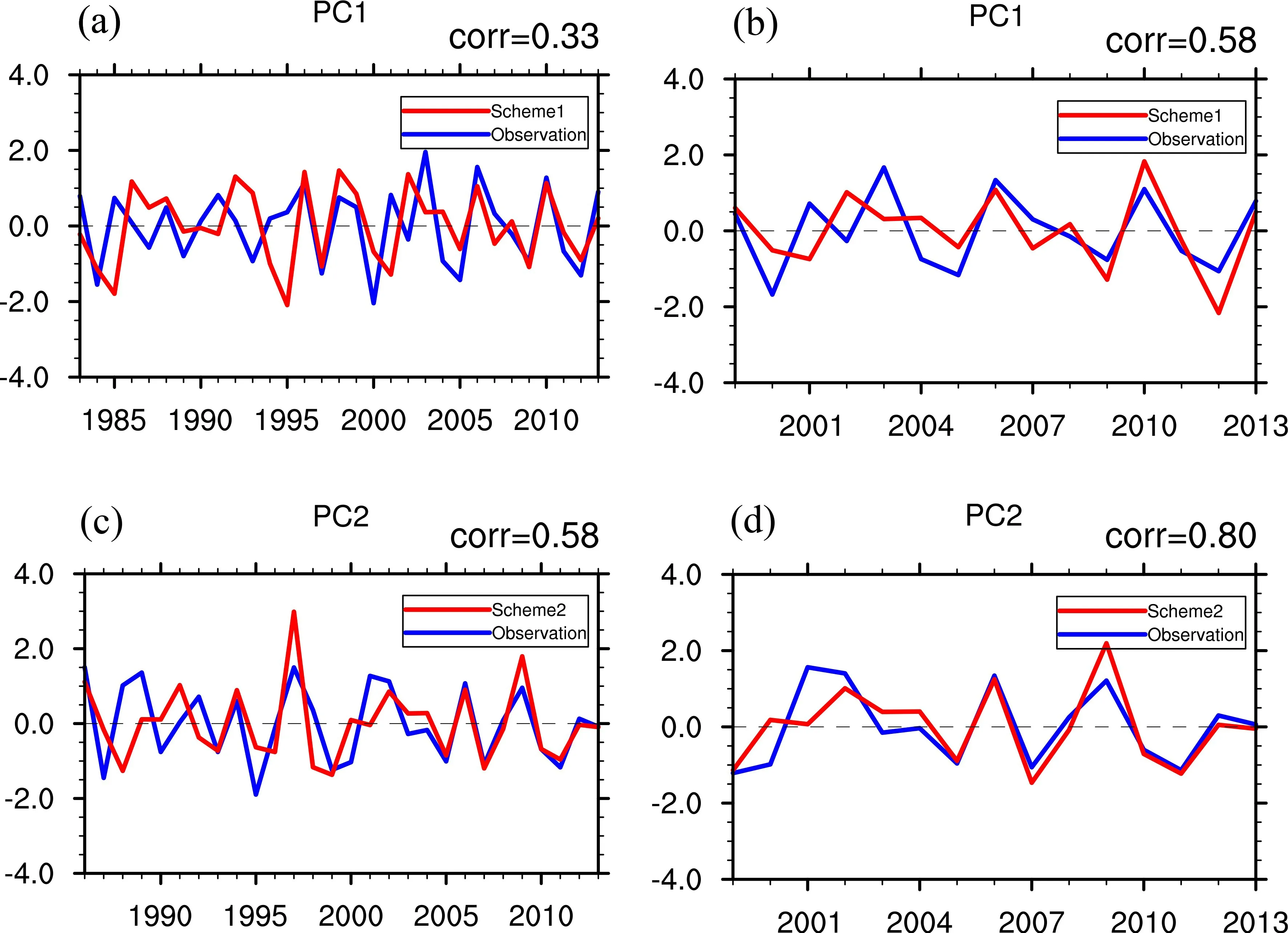
Fig.9.Standardized time series of predicted (red) and observed (blue) PC1 of WVC in (a) the cross-validation test for the period 1983–2013 and (b) the independent hindcasts for the period 1999–2013,with the correlation coefficient labeled in the top-right corner of the panel.Standardized time series of predicted (red) and observed(blue) PC2 of WVC in (c) the cross-validation test for the period 1986–2013 and (d) the independent hindcasts for the period 1999–2013,with the correlation coefficient labeled in the top-right corner of the panel.
Thus,the observed SIC-KSBS in the preceding autumn and the CFS-v2 predicted boreal winter Niño-3 index may be used to improve the prediction of East Asian winter WVC.The above results are only preliminary and need further study.
6.Summary and discussion
In this study,we investigated the leading modes of the interannual variability in WVC over East Asia during winter from 1979–2017 and the underlying mechanisms.EOF1 of the interannual variability in WVC is characterized by opposite WVC anomalies in southern and northern East Asia,whereas EOF2 of the interannual variability in WVC is mainly characterized by uniform WVC anomalies over East Asia.EOF1 of the interannual variability in the WVC is mainly modulated by two anomalous WVT branches over northeastern and eastern China,which are associated with an anomalous high and an anomalous low over Mongolia and the WNP,respectively.The winter AO and the SIC-KSBS in ON may exert an important impact on EOF1 of WVC.The SIC-KSBS in ON can partially regulate the East Asian winter atmospheric circulation by triggering a meridional wave train and affecting the temperature gradient between the Arctic and Eurasia,which in turn affects EOF1 of WVC.EOF2 of WVC is mainly modulated by an anomalous WVT branch across the western boundary of East Asia.The anomalous WVT branch is related to an anomalous high over East Asia,which is connected with a southeastward-propagating wave train over Eurasia.This wave train may be partially attributed to an El Niño-like condition in tropical Pacific SSTs,which may exert an impact on the Northern Hemisphere circumglobal teleconnection and cause an anomalous high over East Asia,further leading to WVC anomalies over East Asia.To verify the robustness of the results and the other reanalysis and SST datasets:ERA5 (2.5° × 2.5°) and HadiSST (1° × 1°,Rayner et al.,2003) are used to perform the statistical analysis (Figs.S2–S10 in the ESM).The results exhibit no significant difference,indicating the above conclusions are for the most part robust.
This study finds several factors that may influence the interannual variability of winter WVC over East Asia,including the AO,the air-sea interactions in the tropical Pacific,and the Arctic sea ice.However,it should be noted that EOF1 and EOF2 of winter WVC have an unstable relationship with the associated mechanisms.For instance,EOF1 and EOF2 of winter WVC have a significant correlation with the SIC-KSBS in ON and the ENSO-like pattern in winter during the early 1980s,the late 1990s,and the late 2000s but have an insignificant relationship with the SICKSBS in ON and the ENSO-like pattern in winter during other episodes,respectively.The above result implies that the mechanisms of interannual variability of winter WVC might vary with extended periods (Ding et al.,2014;Wang et al.,2007),thereby justifying that interdecadal changes of winter WVC over East Asia are worthy of attention.Our preliminary results suggest that the Arctic sea ice in the preceding autumn may also influence the interdecadal variability of winter WVC over East Asia through a mechanism similar to the mechanism of the SIC-KSBS impacting the interannual variability of winter WVC suggested in section 4.1,which requires further study.
This study shows that both the SIC-KSBS in the preceding autumn and the SST over tropical Pacific in winter have important influences on the interannual variability of East Asian winter WVC.Based on the results of a statistical prediction model,we conclude that the observed SIC-KSBS in ON and the CFS-v2 predicted Niño-3 index may be of great significance to improve the prediction of the interannual variations of winter WVC over East Asia.Hence,it is important to improve the numerical modeling capability of SICKSBS and SST over the tropical Pacific to obtain a better prediction of East Asian WVC anomalies.Additionally,the results suggest that both the internal processes of the atmospheric circulation and external factors (e.g.,the Arctic sea ice and tropical SSTs) have important influences on the WVC over East Asia.Under global warming,the interannual variability in the atmospheric internal processes and these external factors have changed significantly (Cai et al.,2011;Hu et al.,2020;Dong et al.,2020).Changes in the influence of atmospheric internal processes and external factors on the East Asian WVC variability under global warming need further investigation.
The statistical prediction model proposed in our study is also well applied to extreme cases.For example,the meridional dipole pattern of winter WVC over East Asia was significant in 2006 (Fig.S11a in the ESM).The positive anomalies of the SIC-KSBS in ON (Fig.S12 in the ESM) may affect the mid-to-high-latitude atmospheric circulation(Figs.S11c and S1d) via regulating the temperature gradient between the KSBS and Eurasia (not shown),which ultimately affects the winter WVC over East Asia in 2006.Moreover,the observed and predicted value of PC1 in 2006 are consistent (Fig.9b),indicating that the dynamic mechanism of EOF1 proposed in our study is of great importance for the prediction of WVC over East Asia in 2006.Similarly,2007 was a year with a significant monopole pattern of winter WVC over East Asia (Fig.S13 in the ESM).During winter of this year,the eastern tropical Pacific the SST exhibits significant positive anomalies (Fig.S14 in the ESM).The SST anomalies may exert an important impact on the winter WVC over East Asia by triggering the Northern Hemisphere circumglobal teleconnection (Fig.S15 in the ESM).Besides,the predicted value of PC2 in 2007 is generally consistent with the observed one (Fig.9d),which justifies the dynamic mechanism of EOF2.The above results suggest that the prediction model can largely predict extreme cases of WVC over East Asia such as 2006 and 2007.However,it should be noted that the prediction efficiency is not satisfactory for some years,especially before 2005 (Figs.9b and 9d),implying the influences of other factors on the dominant mode of WVC over East Asia during winter,which need to be further investigated in the future.
This study was funded by the Natural Science Foundation of China (Grant Nos.41991283 and 41805047)and the Natural Science Foundation of Jiangsu Province of China(Grant No.BK20180807).:Supplementary material is available in the online version of this article at https://doi.org/10.1007/s00376-021-0014-5.杂志排行
Advances in Atmospheric Sciences的其它文章
- China’s EarthLab—Forefront of Earth System Simulation Research
- On the Importance of High-Resolution in Large-Scale Ocean Models
- Projected Increase in Probability of East Asian Heavy Rainy Summer in the 21st Century by CMIP5 Models
- Controls on the Northward Movement of the ITCZ over the South China Sea in Autumn:A Heavy Rain Case Study
- Changes of Extreme Precipitation and its Associated Mechanisms in Northwest China
- All-sky Data Assimilation of MWTS-2 and MWHS-2 in the Met Office Global NWP System.
